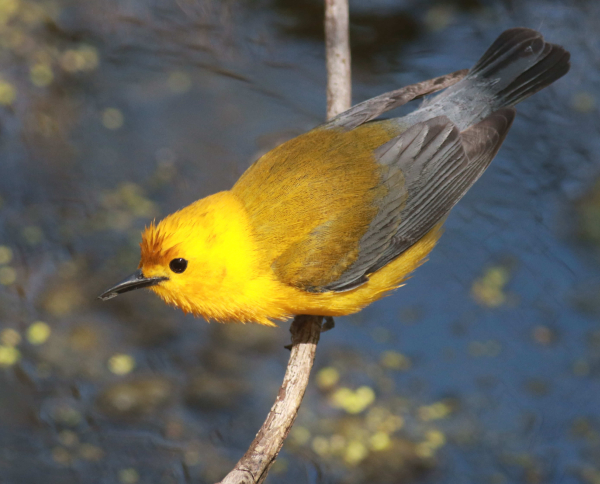
Millions of neotropical migrants, including birds that already face considerable threats to their survival would be threatened, such as Prothonotary Warblers.
|
The Icebreaker Windpower plan, proposed to the Ohio Power Siting Board, has raised dire concerns for millions of migrating birds that cross Lake Erie twice annually, along with wintering waterfowl. Proposed by a Norway-based energy company, the Icebreaker plan would install wind turbines in Lake Erie offshore from Cleveland, Ohio. This wind energy project would be the first offshore facility in the Great Lakes, only the second offshore facility in the United States, and it would raise international concerns from neighboring Canada.
The site selected by the developer – the Central Basin of Lake Erie – has been designated as a Globally Important Bird Area in recognition of the millions of birds that use this area, including threatened migratory species such as Kirtland’s Warblers and a host of other neotropical songbirds. Wintering waterfowl including Red-breasted Mergansers and other waterbirds are also at risk.
Despite dire concerns regarding the high risk of wind turbine-caused mortalities and other impacts on birds, the proposal has moved forward during the past decade as the developer has attempted to win approval of a Certificate of Environmental Compatibility and Public Need (CECPN) from the Ohio Power Siting Board (OPSB).
“Significant and un-addressed concerns remain regarding this project’s potential impacts on bird populations,” said Steve Holmer, Vice President of Policy for the American Bird Conservancy (ABC). “This is a high-risk, inappropriate location for wind energy development, which is why the project is opposed by the ABC and Black Swamp Bird Observatory (BSBO).”
The Ohio Power Siting Board, in conjunction with one of its voting members, the Ohio Department of Natural Resources (ODNR), is approaching the case with caution for a number of ecological reasons. First, the science provided by the applicant, which quantifies birds in flight near the proposed site of the turbines, is imperfect and understates the risk to migrating and wintering birds.
Second, the technology and methods for detecting, identifying, and quantifying bird fatalities resulting from collisions with offshore turbines are in their infancy for pre-construction data collection, and these crucial parameters are currently non-existent for post-construction monitoring. Therefore, existing methods are highly inadequate to gather this critically important information.
To mitigate impacts to birds, the OPSB and the ODNR have proposed placing a number of stipulations on any granting of a Certificate of Environmental Compatibility and Public Need. For almost a year, these stipulations have been the subject of negotiations between Icebreaker Windpower Inc. (a partnership of the developer and Fred Olsen Renewables, a wholly owned subsidiary of Norway-based Bonheur ASA) and the OPSB and ODNR. The stipulations were issued in signed consent on May 15. (One legal participant in the case has refused to sign the stipulations, so there is not yet consent among all parties.)
The Ohio Power Siting Board is conducting a hearing this week to address issues related to the CECPN and the stipulations, which would be considered legally binding and enforceable if the CECPN is issued.
The American Bird Conservancy and Ohio-based Black Swamp Bird Observatory issued a joint comment to the OPSB in regard to these stipulations on May 29. The comment specifies recommendations to improve the inadequate ecological science contained in the stipulations, as well as their mutual ABC and BSBO opposition to the project as a whole.
“Before this experimental project is considered for final approval by OPSB, we have some concerns,” said BSBO Conservation Chair Don Bauman. “We have prepared ‘objections and recommendations’ that, if heeded, could improve the ecological science being used to evaluate the risk this project poses to birds and bats.”
These recommendations are consistent with ABC’s and BSBO’s goals for a science-based approach to Bird-Smart Wind Energy development, and they set an important precedent for any potential offshore wind development in the future.
“On a regional level, all eyes are on the decision-making process for this pilot project,” said Joel Merriman, Director of ABC’s Bird-Smart Wind Energy Campaign. “It is critical that we combat the effects of climate change, but we need to ensure that we’re not creating new problems for bird populations by building in high-risk areas, or not considering better alternatives such as distributed solar power on Cleveland rooftops, parking lots, and brownfields.”
For more information about the American Bird Conservancy and Black Swamp Bird Observatory’s objections and recommendations to the Icebreaker plan, see http://dis.puc.state.oh.us/TiffToPDf/A1001001A19F03B72701E00172.pdf and be sure to check out the ABC’s Bird-Smart Wind Energy Campaign at https://abcbirds.org/program/wind-energy-and-birds/